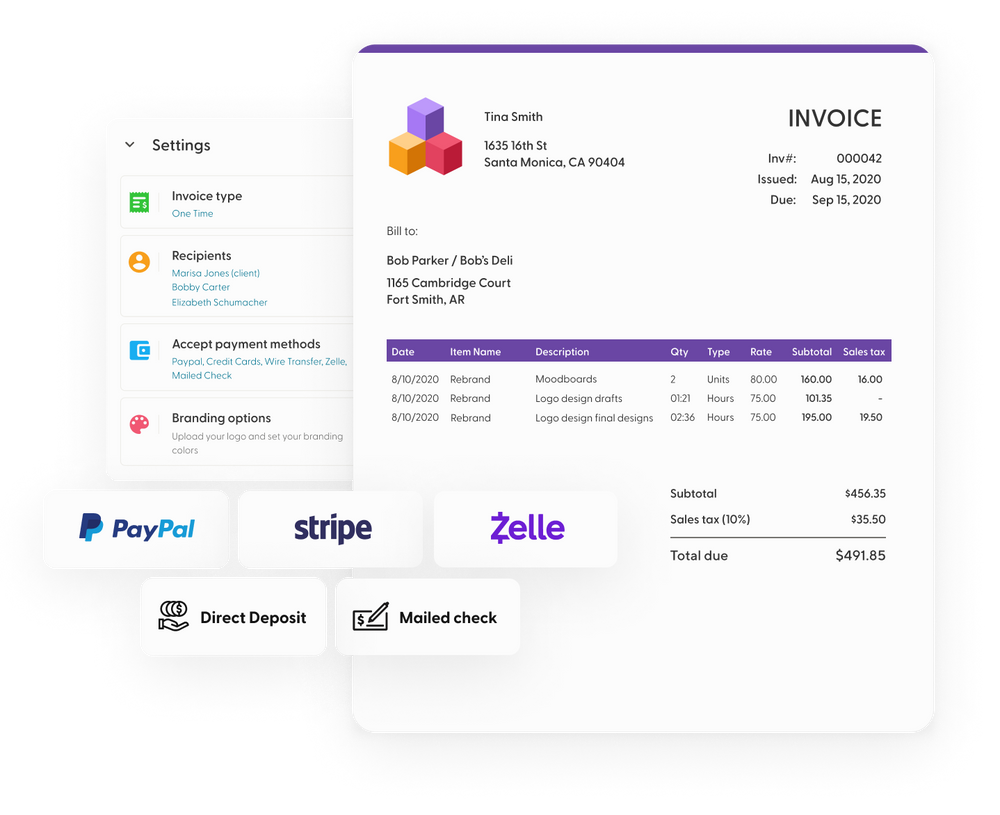Breaking up with a client is never easy. But the only thing worse than having that dreaded breakup conversation is sticking around in a draining or difficult relationship.
Whether positive or negative, the interactions you have with clients can have a direct impact on the work you produce. Not to mention, difficult clients can affect your mental health. If you're working with a client who is causing you stress and frustration, then you're not going to produce your best work and that stress can trickle down into other parts of your life.
It's not fun, but cutting ties with a difficult client is necessary to grow your freelancing business.
In this article, I'll share the things that make a client difficult to work with and how to break up with them in a professional way.
Signs of a problem client
In a perfect world, every client would be a dream to work with. They'd communicate effectively, pay on time, value your work, and maybe even refer you to new clients!
But even if you're lucky enough to work with these ideal clients, you're bound to run into a difficult client or two at some point in your freelancing career. There are a few things that make a client difficult to work with:
- They make it difficult to get paid (or worse, they refuse to pay).
- They're not sure what they want and there's no clear direction, which can result in scope creep.
- They have unreasonable demands and don't respect your boundaries.
- They treat you poorly.
I've worked with a handful of bad clients, especially at the beginning of my freelance writing career. I was eager to take on any work that came my way, ignored the red flags waving wildly in my face, and hoped that the relationship would magically get better. But I can say from experience that working with a difficult client only gets worse.
When I realized that things weren't working out and finally built up the courage to cut ties with a difficult client, it proved to be more than worth it for my freelancing business (and mental health!) in the long run.
If you're ready to part ways with a difficult client, here are the steps you can take.
How to Break Up with a Client
When you recognize the signs that a working relationship is going downhill, then it's time to consider parting ways. Here are some steps you can take to handle this sensitive moment without burning any bridges.
#1 Review the contract
Breaking off business relationships can be tricky. Before you fire off a breakup email, review the contract you have with the client. Whether it's a contract that you created or one that they sent, there should be a clause about termination. Review the details to make sure there's nothing legally binding you to them. If, say, a 30-day notice is required, then be sure to notify them as soon as possible.
It's also worth noting that people don't always read through contracts. This isn't an excuse, but sometimes a client simply doesn't know that they're doing anything wrong unless you bring it to their attention.
If you experience your first red flag with a client — like a missed payment — refer to the contract to let them know that you require payments be made in X amount of days. Think of this as a first warning. If it continues to be an issue, then you should consider moving on.
#2 Be transparent but keep it professional
I'd be lying if I said I haven't tried to come up with a wishy-washy excuse to get out of a client relationship before. But if you're anything like me and just the *thought* of having a difficult conversation is enough to make your stomach hurt, it's important to remember how critical transparency is when cutting ties with a demanding client.
Transparency is empowering. Having honest conversations helps build your confidence as a freelancer and enables you to clearly define how you want to run your business.
On the flip side, you might find that you have no problem letting them know where things went wrong. But before you unpack your frustrations, remember to keep things professional and respectful. Stand your ground, but remain calm.
Follow a script
In either instance, it's a good idea to have a script prepared before the conversation. It doesn't have to be formal, but having a few talking points lined up will help you stay on track and speak with authority.
You can also take some time to write down any objections they might have and what you're responses will be.
Choose a communication method
The mode of communication can affect how your message comes across. While you can respond through email, jumping on a phone call can prevent miscommunication.
How many times have we misinterpreted a text or an email? It can be very difficult to distinguish people's tones when reading words. A heavy topic, like ending a client relationship, can automatically put the client on the defense where each word reads harsher than you meant it to be.
A phone call or video chat will let the client see that you're in good spirits and that this relationship just isn't a good fit.
#3 Prepare a termination date
As desperately as you might want out, you still don't want to catch your client by surprise. For one, your client might not even realize that they are a problem client. To avoid burning bridges, you can prepare an exit day for the project. By doing so, you'll be opening the door to a conversation about why you're choosing to leave.
If your client isn't aware of their behavior, you can politely point out clear expectations for this relationship and where things went wrong.
Setting a date for the contract to end will give you each a chance to prepare for your next steps. As you begin looking for replacement income, your client will appreciate having a little time to look for a replacement to finish this project.
#4 Refer another freelancer
Depending on the nature of the situation, you could offer to connect them with another freelancer. Obviously, if this client wasn't respectful or professional, you wouldn't want to subject a fellow freelancer to a toxic situation.
But maybe your communication styles clashed or the project simply wasn't a good fit; in either case, you may know someone who would be a better match for the client.
This is where being transparent also helps. If you let the client know the reason you can no longer work with them, then (hopefully) they'll be more aware the next time they're working with a freelancer.
#5 Create a smooth transition
When you're ready to end a relationship, you want to prepare for the transition period. If you don't take the necessary steps, this process could drag on much longer than you want it to. Depending on your services, you may even need to help them transition beyond the referral process. This could include:
- Sending them any passwords or files they need to move forward
- Granting them account access to any parts of the project they now own
- Giving them any deliverables you've completed for them
- Explaining the next steps they should take to finish this project
You don't want to drag this process out beyond what it needs to be so be concise by telling them over the phone and sending a document covering the objectives. By having it in writing, you can also have email proof that you took the necessary steps to end the contract on a positive note.
#6 Ending the relationship
By now, you've let your client know the situation, so it's time to start putting the plan into action. If there's any more work you need to finish up before the exit date, finish up that last bit of work.
Your client is still paying you for any work you complete until the contract is terminated so you want to put your best foot forward and deliver great work.
Once all of your work is completed, you can turn in the finished elements of the project and safely end the contract.
Whatever you do, don't ghost them
Just like you wouldn't want a client to ghost you (especially when you're chasing a payment), you should never ghost a client that you don't want to work with anymore.
Not only is ghosting unprofessional, but it's just plain rude. Not to mention, it can have a lasting impact on your reputation. Potential clients talk and word gets around. You don't want to be branded as the flaky type.
But what if they don't pay?
If you're working with less than ideal clients, there's always a chance that they refuse to pay you for the services. If this happens, you can send a polite email wishing them well now that the project has ended, followed by a query about the missing payment. This email should be sent within a day or two of the deadline.
If your email goes unanswered, you can try sending a debt collection letter. A letter will feel more formal and urgent when requesting payment. You should also add a date on which the payment is due.
Lastly, if you make several attempts and the client is choosing to ignore your requests, you can send a final demand or even a lawsuit.
However you choose to settle the situation, you should always begin as politely as possible before increasing the urgency of the matter.
How to find ideal clients
We'd all like to avoid working with bad clients as much as possible, so how do we find good clients? Fortunately, you can learn a lot about a client in the discovery call. And though, clients can change throughout the process, there are some signs to look out for.
- Excellent communication
- Positive attitudes
- Have a clear direction
- Willingness to listen
If the conversation feels effortless and you two are on the same page over the project, then that's a very good sign that you'll have a great working relationship.
Learn from the bad clients
While nobody wants to experience a bad client relationship, on the bright side, you can learn a lot from problem clients. Once you know the signs, you can start to recognize similar behavior patterns in future discovery calls.
When you can recognize the red flags, this bad experience can ultimately save you from having more down the line.
Lastly, remember the good clients
If you've never worked with a bad client before, it can take a toll on your mental health. You didn't choose to be a freelancer so you could work with bad clients. And even though it isn't fun to think about, there will most likely come a time when it happens to you. And when it does, it can be hard to remember all the good clients out there.
In fact, the experience might make you wish to not work with another client again. So when it comes time to end a client relationship, just remember that there are tons of clients out there who are a pleasure to work with.
Conclusion
It can be challenging to know how to break up with a client, or even when to break up with them. But if you follow our guide, remain polite, and put the steps into action, you can be on your way to working with better clients. No matter how difficult the client or difficult the conversation, you owe it to them and yourself to end things in a professional way.
If you'd like to get on the right page with a client from the start, make sure to have a solid contract using Indy's contracts tool.




